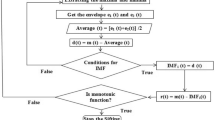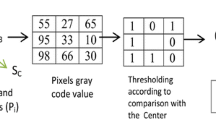Abstract
Epilepsy is a well-known nervous system disorder characterized by seizures. Electroencephalograms (EEGs), which capture brain neural activity, can detect epilepsy. Traditional methods for analyzing an EEG signal for epileptic seizure detection are time-consuming. Recently, several automated seizure detection frameworks using machine learning technique have been proposed to replace these traditional methods. The two basic steps involved in machine learning are feature extraction and classification. Feature extraction reduces the input pattern space by keeping informative features and the classifier assigns the appropriate class label. In this paper, we propose two effective approaches involving subpattern based PCA (SpPCA) and cross-subpattern correlation-based PCA (SubXPCA) with Support Vector Machine (SVM) for automated seizure detection in EEG signals. Feature extraction was performed using SpPCA and SubXPCA. Both techniques explore the subpattern correlation of EEG signals, which helps in decision-making process. SVM is used for classification of seizure and non-seizure EEG signals. The SVM was trained with radial basis kernel. All the experiments have been carried out on the benchmark epilepsy EEG dataset. The entire dataset consists of 500 EEG signals recorded under different scenarios. Seven different experimental cases for classification have been conducted. The classification accuracy was evaluated using tenfold cross validation. The classification results of the proposed approaches have been compared with the results of some of existing techniques proposed in the literature to establish the claim.







Similar content being viewed by others
Notes
EEG time series dataset http://epileptologie-bonn.de/cms/front_content.php?idcat=193&lang=3&changelang=3
References
WHO (2016) Epilepsy. http://www.who.int/mediacentre/factsheets/fs999/en/. Accessed Aug 2016
Berger H (1929) Über das elektrenkephalogramm des menschen. Eur Archiv Psychiatr Clin Neurosci 87(1):527–570
Ray GC (1994) An algorithm to separate nonstationary part of a signal using mid-prediction filter. IEEE Trans Signal Process 42(9):2276–2279
Iasemidis LD, Shiau DS, Chaovalitwongse W, Sackellares JC, Pardalos PM, Principe JC, Carney PR, Prasad A, Veeramani B, Tsakalis K (2003) Adaptive epileptic seizure prediction system. IEEE Trans Biomed Eng 50(5):616–627
Srinivasan V, Eswaran C, Sriraam N (2005) Artificial neural network based epileptic detection using time-domain and frequency-domain features. J Med Syst 29(6):647–660
Ghosh-Dastidar S, Adeli H, Dadmehr N (2007) Mixed-band wavelet-chaos-neural network methodology for epilepsy and epileptic seizure detection. IEEE Trans Biomed Eng 54(9):1545
Polat K, Güneş S (2007) Classification of epileptiform EEG using a hybrid system based on decision tree classifier and fast fourier transform. Appl Math Comput 187(2):1017–1026
Subasi A (2007) EEG signal classification using wavelet feature extraction and a mixture of expert model. Expert Syst Appl 32(4):1084–1093
Hasan O (2009) Automatic detection of epileptic seizures in EEG using discrete wavelet transform and approximate entropy. Expert Syst Appl 36(2):2027–2036
Li D, Xie Q, Jin Q, Hirasawa K (2016) A sequential method using multiplicative extreme learning machine for epileptic seizure detection. Neurocomputing 214:692–707
Satapathy SK, Dehuri S, Jagadev AK (2017) ABC optimized RBF network for classification of EEG signal for epileptic seizure identification. Egypt Inform J 18:55–66
Guo L, Rivero D, Pazos A (2010) Epileptic seizure detection using multiwavelet transform based approximate entropy and artificial neural networks. J Neurosci Methods 193(1):156–163
Chen L-L, Zhang J, Zou J-Z, Zhao C-J, Wang G-S (2014) A framework on wavelet-based nonlinear features and extreme learning machine for epileptic seizure detection. Biomed Signal Process Control 10:1–10
Swami P, Gandhi TK, Panigrahi BK, Bhatia M, Santhosh J, Anand S (2016) A comparative account of modelling seizure detection system using wavelet techniques. Int J Syst Sci Oper Logist 4:1–12
Tzallas AT, Tsipouras MG, Fotiadis DI (2009) Epileptic seizure detection in EEGs using time–frequency analysis. IEEE Trans Inform Technol Biomed 13(5):703–710
Altunay S, Telatar Z, Erogul O (2010) Epileptic EEG detection using the linear prediction error energy. Expert Syst Appl 37(8):5661–5665
Ghosh-Dastidar S, Adeli H, Dadmehr N (2008) Principal component analysis-enhanced cosine radial basis function neural network for robust epilepsy and seizure detection. IEEE Trans Biomed Eng 55(2):512–518
Subasi A, Gursoy MI (2010) EEG signal classification using PCA, ICA, IDA and support vector machines. Expert Syst Appl 37(12):8659–8666
Kaya Y, Uyar M, Tekin R, Yıldırım S (2014) 1D-local binary pattern based feature extraction for classification of epileptic EEG signals. Appl Math Comput 243:209–219
Joshi V, Pachori RB, Vijesh A (2014) Classification of ictal and seizure-free EEG signals using fractional linear prediction. Biomed Signal Process Control 9:1–5
Chen S, Zhu Y (2004) Subpattern-based principle component analysis. Pattern Recognit 37(5):1081–1083
Kadappagari VK, Atul N (2008) SubXPCA and a generalized feature partitioning approach to principal component analysis. Pattern Recognit 41(4):1398–1409
Kai F, Jianfeng Q, Chai Y, Dong Y (2014) Classification of seizure based on the time–frequency image of EEG signals using HHT and SVM. Biomed Signal Process Control 13:15–22
Kadappa VK, Negi A (2013) Computational and space complexity analysis of subXPCA. Pattern Recognit 46(8):2169–2174
Burges CJC (1998) A tutorial on support vector machines for pattern recognition. Data Min Knowl Discov 2(2):121–167
Cheng J, Dejie Y, Yang Y (2008) A fault diagnosis approach for gears based on IMF AR model and SVM. EURASIP J Adv Signal Process 2008(1):1–7
Andrzejak RG, Lehnertz K, Mormann F, Rieke C, David P, Elger CE (2001) Indications of nonlinear deterministic and finite-dimensional structures in time series of brain electrical activity: dependence on recording region and brain state. Phys Rev E 64(6):061907
Kohavi R et al (1995) A study of cross-validation and bootstrap for accuracy estimation and model selection. Ijcai 14:1137–1145
Xindong W, Vipin Kumar J, Quinlan R, Ghosh J, Yang Q, Motoda H, McLachlan GJ, Ng A, Liu B, Philip SY (2008) Top 10 algorithms in data mining. Knowl Inform Syst 14(1):1–37
Nigam VP, Graupe D (2004) A neural-network-based detection of epilepsy. Neurol Res 26(1):55–60
Kannathal N, Choo Min Lim, Acharya U Rajendra, Sadasivan PK (2005) Entropies for detection of epilepsy in EEG. Comput Methods Progr Biomed 80(3):187–194
Tzallas AT, Tsipouras MG, Fotiadis DI (2007) Automatic seizure detection based on time–frequency analysis and artificial neural networks. Comput Intell Neurosci. http://doi.org/10.1155/2007/80510
Srinivasan V, Eswaran C, Sriraam N (2007) Approximate entropy-based epileptic EEG detection using artificial neural networks. IEEE Trans Inform Technol Biomed 11(3):288–295
Guo L, Rivero D, Seoane JA, Pazos A (2009) Classification of EEG signals using relative wavelet energy and artificial neural networks. In: Proceedings of the first ACM/SIGEVO summit on genetic and evolutionary computation, pp 177–184
Chandaka S, Chatterjee A, Munshi S (2009) Cross-correlation aided support vector machine classifier for classification of EEG signals. Expert Syst Appl 36(2):1329–1336
Iscan Z, Dokur Z, Demiralp T (2011) Classification of electroencephalogram signals with combined time and frequency features. Expert Syst Appl 38(8):10499–10505
Wang D, Miao D, Xie C (2011) Best basis-based wavelet packet entropy feature extraction and hierarchical EEG classification for epileptic detection. Expert Syst Appl 38(11):14314–14320
Nicolaou N, Georgiou J (2012) Detection of epileptic electroencephalogram based on permutation entropy and support vector machines. Expert Syst Appl 39(1):202–209
Kumar Y, Dewal ML, Anand RS (2014) Epileptic seizure detection using DWT based fuzzy approximate entropy and support vector machine. Neurocomputing 133:271–279
Lee S-H, Lim JS, Kim J-K, Yang J, Lee Y (2014) Classification of normal and epileptic seizure eeg signals using wavelet transform, phase-space reconstruction, and euclidean distance. Comput Methods Progr Biomed 116(1):10–25
Tawfik NS, Youssef SM, Kholief M (2016) A hybrid automated detection of epileptic seizures in EEG records. Comput Electr Eng 53:177–190
Sharma R, Pachori RB (2015) Classification of epileptic seizures in EEG signals based on phase space representation of intrinsic mode functions. Expert Syst Appl 42(3):1106–1117
Tiwari A et al (2016) Automated diagnosis of epilepsy using key-point based local binary pattern of EEG signals. IEEE J Biomed Health Inform 21(4):888–896
Hassan AR, Subasi A (2016) Automatic identification of epileptic seizures from EEG signals using linear programming boosting. Comput Methods Progr Biomed 136:65–77
Acknowledgements
The authors would like to thank Dr. R.G. Andrzejak of the University of Bonn for providing the EEG time series dataset.
Author information
Authors and Affiliations
Corresponding author
Ethics declarations
Conflict of interest
The authors declare that they have no competing interests.
Ethical approval
All procedures performed in studies involving human participants were in accordance with the ethical standards of the institutional and/or national research committee and with the 1964 Helsinki declaration and its later amendments or comparable ethical standards.
Informed consent
The used dataset is publicly available.
Rights and permissions
About this article
Cite this article
Jaiswal, A.K., Banka, H. Epileptic seizure detection in EEG signal using machine learning techniques. Australas Phys Eng Sci Med 41, 81–94 (2018). https://doi.org/10.1007/s13246-017-0610-y
Received:
Accepted:
Published:
Issue Date:
DOI: https://doi.org/10.1007/s13246-017-0610-y




